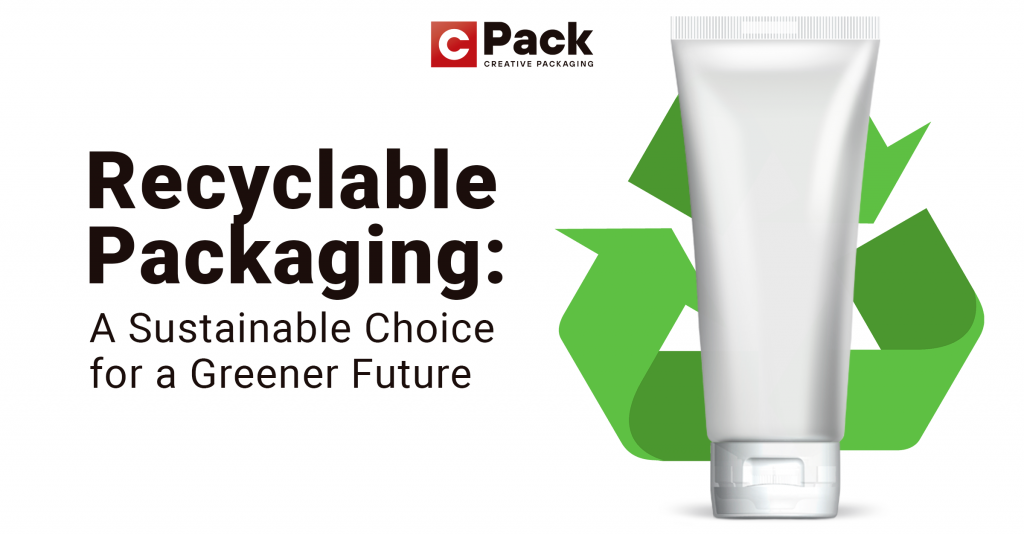
The Urgent Need for Sustainable Packaging Solutions
In a world grappling with environmental challenges, sustainable choices have become paramount. One significant area where individuals and businesses can make a positive impact is packaging. Recyclable packaging is emerging as a crucial solution to combat waste, pollution, and the depletion of resources. By opting for recyclable packaging, we can actively contribute to a greener future. Let’s delve into the benefits and importance of recyclable packaging and its potential to shape a sustainable world.
Environmental Impact: Reducing Waste and Minimizing Pollution
Recyclable packaging plays a vital role in reducing waste and minimizing pollution. Traditional packaging, such as single-use plastics, often ends up in landfills or oceans, posing severe environmental hazards. In contrast, recyclable packaging materials can be collected, processed, and transformed into new products. By embracing recyclable packaging, we divert materials from landfills, decrease the demand for raw materials, and alleviate the burden on our ecosystems. This shift significantly reduces pollution and conserves natural resources.
Recycling Process: Closing the Loop and Conserving Resources
The recycling process associated with recyclable packaging completes a vital loop in the lifecycle of materials. It involves collection, sorting, cleaning, and transforming discarded packaging into reusable materials. Recycling conserves valuable resources like energy, water, and raw materials. It reduces the need for extraction and manufacturing processes that have significant environmental impacts. By participating in recycling initiatives and using recyclable packaging, we contribute to the circular economy, minimizing waste and preserving resources for future generations.
Consumer Preference: Aligning with Eco-Conscious Values
Today’s consumers increasingly prioritize sustainable choices, and packaging is no exception. Many individuals are actively seeking products that align with their eco-conscious values. Recyclable packaging resonates with these consumers as it represents a commitment to reducing environmental impact. By opting for products packaged in recyclable materials, consumers can make a tangible difference. Their choices send a clear message to manufacturers and retailers, encouraging them to embrace sustainable practices and prioritize recyclable packaging options.
Industry Shift: Embracing Recyclable Packaging for a Sustainable Future
The packaging industry plays a significant role in driving the adoption of recyclable packaging solutions. Many businesses are recognizing the importance of sustainability and are actively transitioning to recyclable alternatives. Manufacturers are exploring innovative materials, such as bioplastics and paper-based options, that are easily recyclable. Companies are also redesigning packaging to use fewer materials and optimize recyclability. This industry-wide shift toward recyclable packaging is driven by consumer demand, environmental awareness, and a commitment to a sustainable future.
Taking Action: Embracing Recyclable Packaging for a Greener Future
As individuals, we can take concrete steps to embrace eco-friendly packaging and contribute to a greener future. Start by actively seeking out products packaged in recyclable materials and supporting brands that prioritize sustainability. Properly separate and recycle packaging waste in designated recycling bins. Educate yourself and others about the importance of recycling and the benefits of recyclable packaging. By making conscious choices and advocating for eco-friendly packaging, we can create a significant positive impact on the environment.
In conclusion, recyclable packaging represents a sustainable choice for a greener future. By reducing waste, minimizing pollution, and conserving resources, recyclable packaging plays a crucial role in combating environmental challenges. Consumers and businesses alike can embrace recyclable packaging to align with eco-conscious values, promote industry-wide change, and actively contribute to a more sustainable world. Through collective action and conscious choices, we can create a future where recyclable packaging is the norm, paving the way for a greener and more sustainable society.
Common questions asked about Recyclable Packaging:
1. Why is recyclable packaging important for reducing environmental impact and promoting sustainability?
Recyclable packaging is crucial for reducing environmental impact and promoting sustainability because it diverts materials from landfills, minimizes pollution, and conserves natural resources. By recycling packaging materials, we decrease waste, reduce the need for raw materials, and contribute to a circular economy that prioritizes reuse and conservation.
2. What are the challenges and opportunities in designing and manufacturing recyclable packaging solutions?
Designing and manufacturing recyclable packaging solutions present both challenges and opportunities. The challenges include finding suitable materials that are recyclable, maintaining product integrity, and ensuring cost-effectiveness. However, these challenges also create opportunities for innovation, such as exploring new recyclable materials, optimizing tube design for recyclability, and collaborating with recycling facilities to improve the recycling process.
3. How can brands ensure proper recycling of their packaging materials by consumers?
Brands can ensure proper recycling of their packaging materials by educating consumers about recycling practices. Clear labeling with recycling symbols and instructions can guide consumers on how to dispose of packaging correctly. Collaborating with local recycling programs, providing incentives for recycling, and implementing take-back programs can also encourage consumers to recycle packaging materials responsibly.
4. What are some successful examples of brands implementing effective recyclable packaging strategies?
One successful example is C-Pack, a leading brand that has implemented effective eco packaging strategies. C-Pack uses eco-friendly materials like bioplastics and paper-based packaging, which are easily recyclable. They also prioritize packaging design that minimizes material usage and optimizes recyclability. Through consumer education and collaborations with recycling facilities, C-Pack ensures proper recycling of their packaging materials, contributing to a sustainable approach.
5. What are the long-term benefits and implications of transitioning to recyclable packaging for brands and the environment?
Transitioning to eco packaging offers numerous long-term benefits. Brands that adopt these packaging strategies enhance their brand reputation, attract environmentally conscious consumers, and align with sustainability goals. From an environmental perspective, the long-term implications include reduced waste, decreased pollution, and preserved natural resources. By embracing eco-friendly packaging, brands can lead the way towards a more sustainable future and contribute to a healthier planet.

